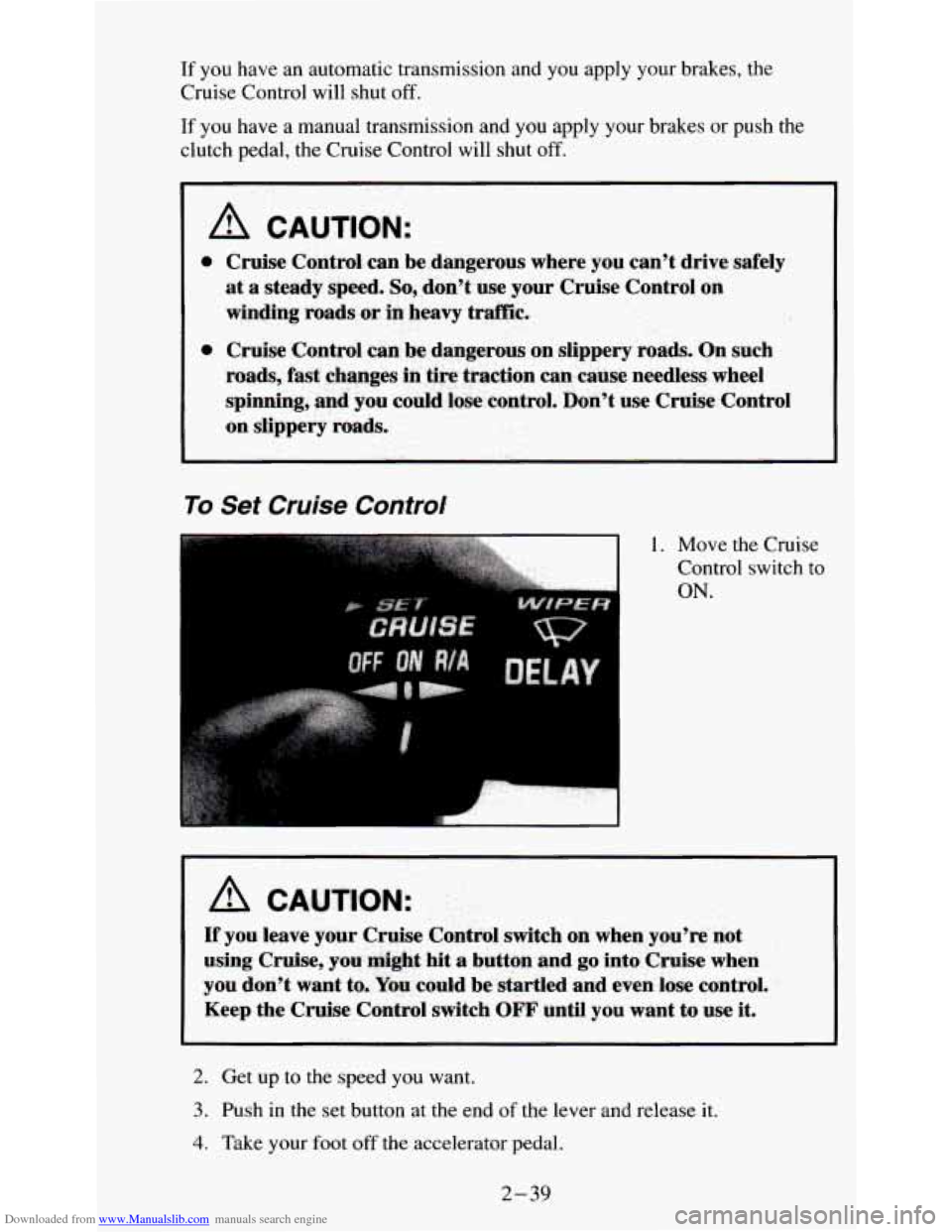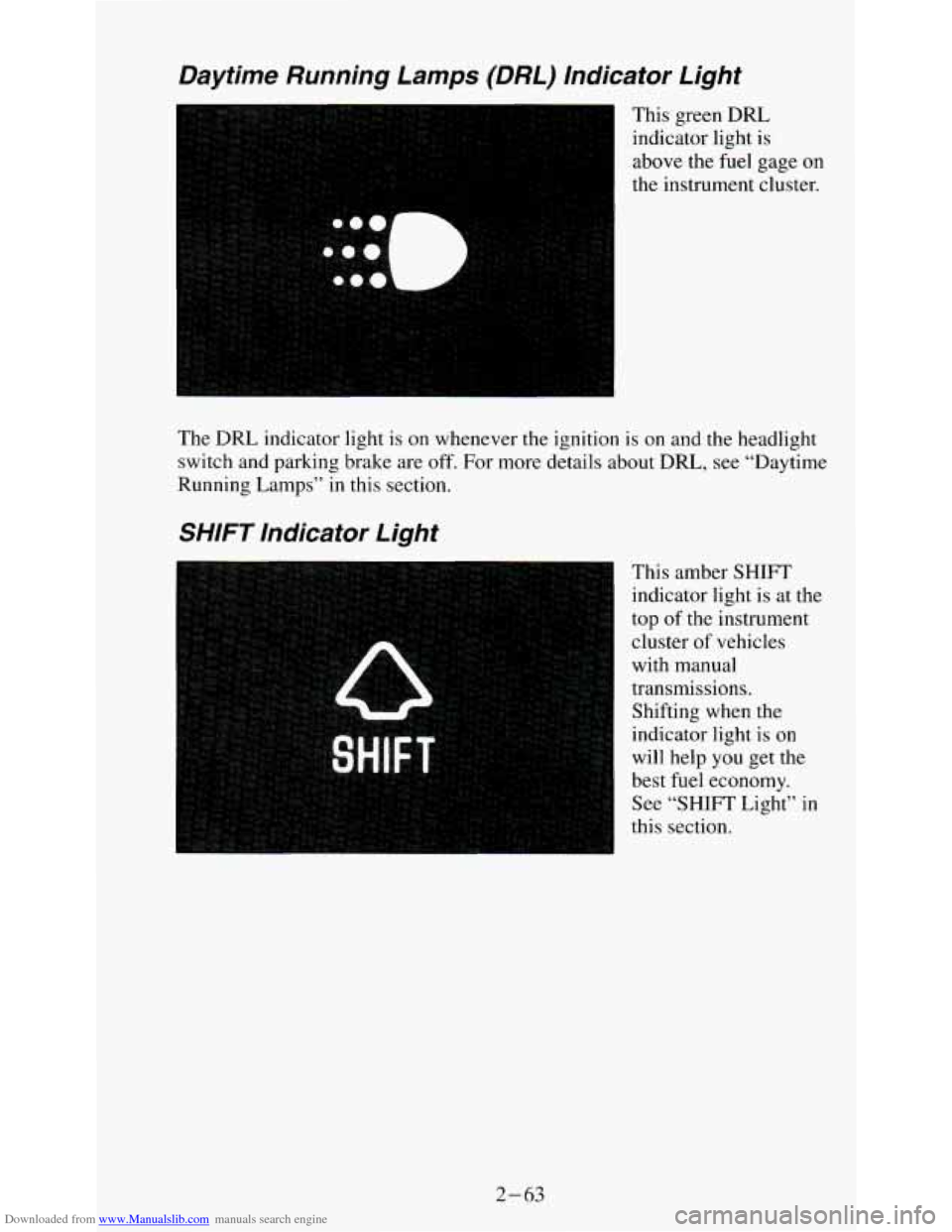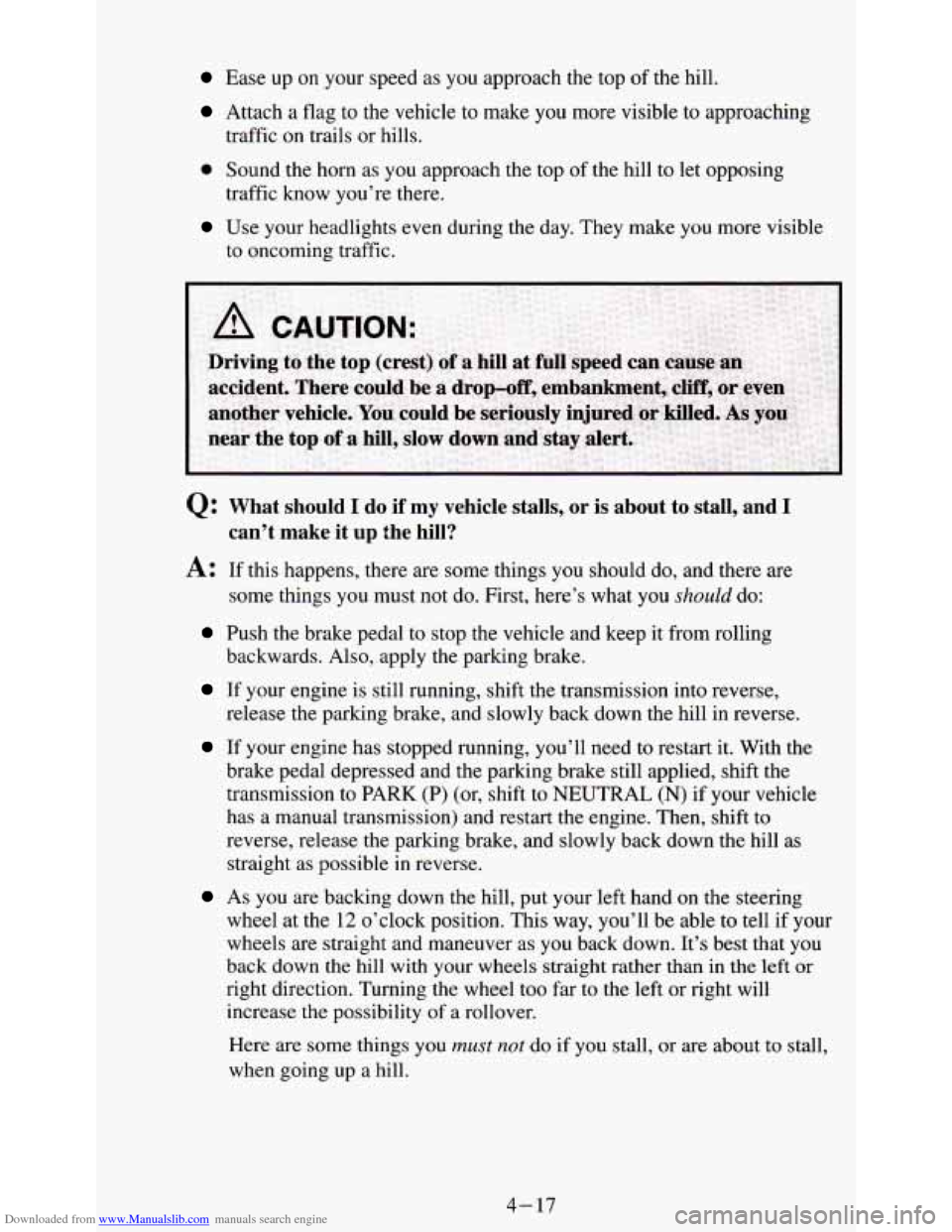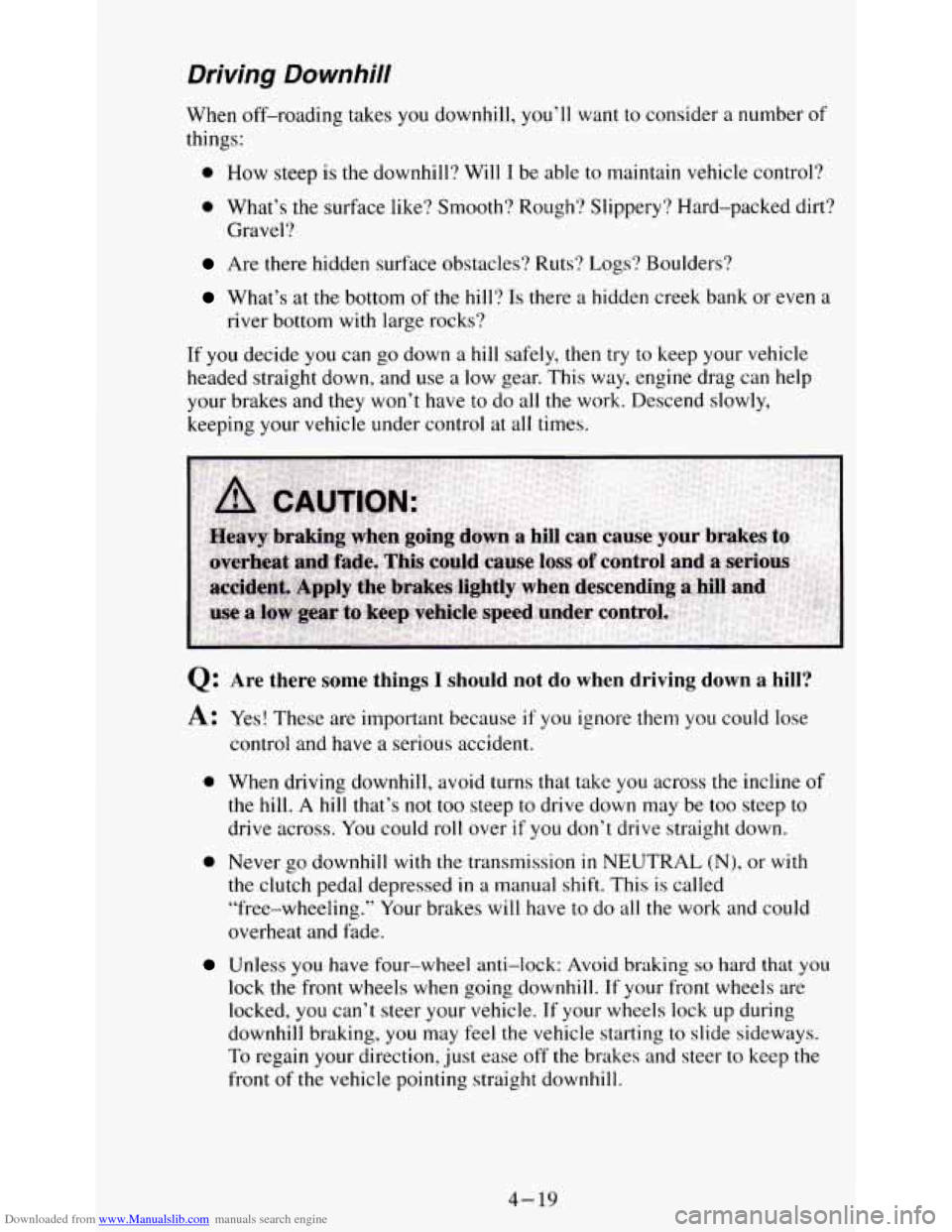1995 CHEVROLET S10 transmission
[x] Cancel search: transmissionPage 76 of 354

Downloaded from www.Manualslib.com manuals search engine If the 4LO switch is pressed when your vehicle is in gear and/or moving, the
amber
4LO indicator light will flash for 30 seconds and not complete the
shift unless your vehicle is below
3 mph (4.8 km/h) and the transmission is
in
NEUTRAL (N) or the clutch pedal depressed.
On automatic transmission equipped vehicles:
If your transfer case does not
shift into
4L0, your transmission indicator switch may require adjustment.
With your transmission in
NEUTRAL (N), press and release the 4LO
switch. While the amber 4LO indicator light is flashing, shift your
transmission into
PARK (P).
Wait until the 4LO indicator light goes solid amber before shifting your
transmission into gear. This will get you into
4L0, but you should take your
vehicle in for service
so normal operation can be restored.
To shift from 4LO to 4HI - Your vehicle must be stopped or moving less
than
3 mph (4.8 km/h) with the transmission in NEUTRAL (N) or the clutch
pedal depressed. The preferred method for shifting out of
4LO is to have
your vehicle slowly moving
1 to 2 mph ( 1.6 to 3.2 km/h). Press and release
the
4HI switch. You must wait for the 4HI indicator light to stop flashing
and go solid amber before shifting your transmission into gear or releasing
the clutch pedal.
If the
4HI switch is pressed when your vehicle is in gear and/or moving, the
4HI indicator light will flash for 30 seconds but not complete the shift
unless the vehicle is below
3 mph (4.8 kmh) and the transmission is in
NEUTRAL (N) or the clutch pedal depressed.
On automatic transmission equipped vehicles:
If your transfer case does not
shift into
4H1, your transmission indicator switch may require adjustment.
With your transmission
in NEUTRAL (N), press and release the 4HI switch.
While the
4HI indicator light is flashing, shift your transmission into PARK
(P). Wait until the 4HI indicator light goes solid amber before shifting your
transmission into gear. This will get you into
4H1, but you should take your
vehicle in for service
so normal operation can be restored.
2-31
Page 84 of 354

Downloaded from www.Manualslib.com manuals search engine If you have an automatic transmission and you apply your brakes, the
Cruise Control will shut
off.
If you have a manual transmission and you apply your brakes or push the
clutch pedal, the
Cruise Control will shut off.
To Set Cruise Control
1. Move the Cruise
Control switch
to
ON.
A CAUTION:
If you leave your Cruise Control switch on when you're not
using Cruise, you
mi&€ hit a button and go into Cruise when
you don't want to- Yaw could be startled and even lose control.
Keep the Cruise Control switch OFF until you want to use it.
2. Get up to the speed you want.
3. Push in the set button at the end of the lever and release it.
4. Take your foot off the accelerator pedal.
2-39
Page 87 of 354

Downloaded from www.Manualslib.com manuals search engine Using Cruise Control on Hills
How well your Cruise Control will work on hills depends upon your speed,
load, and the steepness of the hills. When going up steep hills, you may
want to step on the accelerator pedal to maintain your speed. When going
downhill, you may have to brake
or shift to a lower gear to keep your speed
down. Of course, applying the brake takes you
out of Cruise Control. Many
drivers find this to be too much trouble and don’t
use Cruise Control on
steep hills.
To Get Out of Cruise Control
There are two ways to turn off the Cruise Control:
To Erase Speed Memory
0 Step lightly on
the brake pedal or
push the clutch
pedal,
if you have
a manual
transmission.
0 Move the Cruise
switch to
OFF.
When you turn off the Cruise Control or the ignition, your Cruise Control
set speed memory is erased.
2-42
Page 101 of 354

Downloaded from www.Manualslib.com manuals search engine Normal operating range shows your engine speed during normal driving
conditions. For example, when the needle points
to 2, it means the engine is
running at
2,000 revolutions per minute (rpm). The tachometer needle will
vary all the time that the engine is running.
The red warning range tells you that your engine speed is reaching its upper
limits. Don’t drive very long with the tachometer in the red warning range.
If you have a manual transmission, shift to a higher gear as soon as possible.
If you have an automatic transmission, lift your foot off of the accelerator
pedal. If
you drive for very long with the tachometer in the red danger
range, engine damage will result.
I NOTICE:
Do not operate the engine with the tachometer in the red range,
or engine damage
will occur.
The red danger range tells you that your engine speed is at its upper limits.
You should immediately shift to a higher gear, or lift your
foot off of the
accelerator pedal. If you drive for very long with the tachometer in the red
danger range, engine damage will result.
Warning Lights and Indicators
This part describes the warning lights and gages that may be on your
vehicle.
The pictures will help you locate them.
Warning lights and gages can signal that something is wrong before it
becomes serious enough
to cause an expensive repair or replacement.
Paying attention to your warning lights and gages could also save you or
others from injury.
Warning lights come on when there may be or is a problem with one of your
vehicle’s functions.
As you will see in the details on the next few pages,
some warning lights come on briefly when you start the engine just to let
you know they’re working. If
you are familiar with this section, you should
not be alarmed when this happens.
Gages can indicate when there may be or is a problem with one
of your
vehicle’s functions. Often gages and warning lights work together to let you
know when there’s a problem with your vehicle.
When one
of the warning lights comes on and stays on when you are
driving, or when one
of the gages shows there may be a problem, check the
section that
tells you what to do about it. Please follow this manual’s advice.
Waiting to do repairs can be costly
- and even dangerous. So please get to
know your warning lights and gages. They’re a big help.
2-56
Page 108 of 354

Downloaded from www.Manualslib.com manuals search engine Daytime Running Lamps (DRL) Indicator Light
This green DRL
indicator light is
above the fuel gage on
the instrument cluster.
The
DRL indicator light is on whenever the ignition is on and the headlight
switch and parking brake are off. For more details about
DRL, see “Daytime
Running
Lamps” in this section.
SHIFT Indicator Light
This amber SHIFT
indicator light is at the
top of the instrument
cluster of vehicles
with manual
transmissions.
Shifting when the
indicator light
is on
will help
you get the
best fuel economy.
See “SHIFT Light”
in
this section.
2- 63
Page 150 of 354

Downloaded from www.Manualslib.com manuals search engine Ease up on your speed as you approach the top of the hill.
Attach a flag to the vehicle to make you more visible to approaching
traffic
on trails or hills.
0 Sound the horn as you approach the top of the hill to let opposing
traffic know you’re there.
Use your headlights even during the day. They make you more visible
to oncoming traffic.
Q: What should I do if my vehicle stalls, or is about to stall, and I
can’t make it up the hill?
A: If this happens, there are some things you should do, and there are
some things you must not do. First, here’s what
you should do:
Push the brake pedal to stop the vehicle and keep it from rolling
backwards. Also, apply the parking brake.
If your engine is still running, shift the transmission into reverse,
release the parking brake, and slowly back down the hill in reverse.
If your engine has stopped running, you’ll need to restart it. With the
brake pedal depressed and the parking brake still applied, shift the
transmission to PARK (P) (or, shift to NEUTRAL
(N) if your vehicle
has a manual transmission) and restart the engine. Then, shift to
reverse, release the parking brake, and slowly back down the hill as
straight as possible
in reverse.
As you are backing down the hill, put your left hand on the steering
wheel at the
12 o’clock position. This way, you’ll be able to tell if your
wheels are straight and maneuver as
you back down. It’s best that you
back down the hill with your wheels straight rather than in the left or
right direction. Turning the wheel
too far to the left or right will
increase the possibility of a rollover.
Here are some things you
must not do if you stall, or are about to stall,
when going up a hill.
4-17
Page 151 of 354

Downloaded from www.Manualslib.com manuals search engine 0 Never attempt to prevent a stall by shifting into NEUTRAL (N) (or
depressing the clutch,
if you have a manual transmission) to “rev-up”
the engine and regain forward momentum. This won’t work. Your
vehicle will roll backwards very quickly and you could
go out of
control.
Instead, apply the regular brake
to stop the vehicle. Then apply the parking
brake. Shift into reverse, release the parking brake, and slowly back straight
down.
Never attempt to turn around if you are about to stall when going up a
hill. If the
hill is steep enough to stall your vehicle, it’s steep enough to
cause you
to roll over if you turn around. If you can’t make it up the
hill, you must back straight down the hill.
Q: Suppose, after stalling, I try to back down the hill and decide I just
can’t do
it. What should I do?
A: Set the parking brake, put your transmission in PARK (P) (or the
manual transmission in first gear), and turn off
the engine. Leave the
vehicle and
go get some help. Exit on the uphill side and stay clear of
the path the vehicle would take if it rolled downhill.
Do not shift the
transfer case to NEUTRAL (N) when you leave the vehicle. Leave it in
some gear.
4- 18
Page 152 of 354

Downloaded from www.Manualslib.com manuals search engine Driving Downhill
When off-roading takes you downhill, you’ll want to consider a number of
things:
0 How steep is the downhill? Will I be able to maintain vehicle control?
0 What’s the surface like? Smooth? Rough? Slippery? Hard-packed dirt?
Gravel?
Are there hidden surface obstacles? Ruts? Logs? Boulders?
What’s at the bottom of the hill? Is there a hidden creek bank or even a
river bottom with large rocks?
If
you decide you can go down a hill safely, then try to keep your vehicle
headed straight down, and use
a low gear. This way, engine drag can help
your brakes and they won’t have
to do all the work. Descend slowly,
keeping your vehicle under control at all times.
Q: Are there some things I should not do when driving down a hill?
A: Yes! These are important because if you ignore them you could lose
control and have a serious accident.
0 When driving downhill, avoid turns that take you across the incline of
the hill. A hill that’s not too steep to drive down may be too steep to
drive across. You could roll over if you don’t drive straight down.
0 Never go downhill with the transmission in NEUTRAL (N), or with
the clutch pedal depressed in a manual shift. This is called
“free-wheeling.” Your brakes will have
to do all the work and could
overheat and fade.
Unless you have four-wheel anti-lock: Avoid braking so hard that you
lock the front wheels when going downhill. If your front wheels are
locked, you can’t steer your vehicle.
If your wheels lock up during
downhill braking, you may feel the vehicle starting
to slide sideways.
To regain your direction, just ease off
the brakes and steer to keep the
front of the vehicle pointing straight downhill.
4- 19